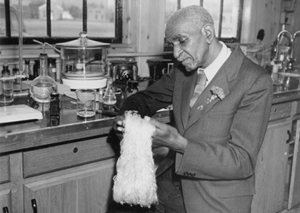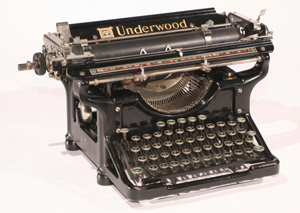| |
 |
 |
George Washington Carver examining a cotton roving, 1939. P.188.26230 |
Typewriter used by George Washington Carver at the Tuskegee Institute. 97.6.2 |
At The Henry Ford, we collect objects for their personal stories—as well as for their value as interesting and important things that reflect the larger American experience. We acquired this early 20th century microscope and typewriter because they had belonged to George Washington Carver (1864-1943). Carver was a pioneering agricultural and environmental scientist who wanted to build up both depleted Southern soils and the farmers who tilled them. He spent most of his career at the Tuskegee Institute in Alabama, a school founded in 1881 that offered economic empowerment for African-Americans by training teachers and providing the up-to-date knowledge needed to succeed at farming and other trades.
The microscope is a classic monocular (“one eye”) device made by Bausch and Lomb around 1900, used for visualizing the smallest components of life. Carver used it to analyze plants of the fields and woods, examining the structures of peanuts and other legumes to see how they might be used to improve the commercial possibilities of crops. Carver devoted his career to helping the South recover from cotton production that had robbed local soils of nutrition and local farmers of economic opportunity, mostly through developing new crops and products derived from them.
During his time teaching and doing research at the Tuskegee Institute, Carver struggled to get funds for appropriate laboratory equipment. The agricultural sciences lab that greeted him when he arrived in Alabama in 1896 was mostly bare. Carver made his own apparatus out of materials at hand, but continued to lobby Booker T. Washington, the director of Tuskegee, for more money for equipment. Some upgraded lab equipment finally arrived around 1910--this microscope may possibly have been one of those pieces. It certainly was used by Carver at Tuskegee in his later years.
The typewriter is an Underwood No. 5 manual typewriter, a common typewriter found in offices and laboratories all over America during the early 20th century. But this typewriter was used by George Washington Carver at the Tuskegee Institute. Carver probably typed scientific reports and agricultural bulletins on this typewriter—he generally preferred to write personal letters by hand.
We know this microscope and typewriter were Carver’s because they were cherished by his friend and assistant Austin W. Curtis Jr. (1911-2003). George Washington Carver was a private man who never married. His fellow scientists and students were his closest friends. Carver mentored students at Tuskegee and continued to support their careers as they made their way in a segregated scientific world. Curtis, who received his PhD in chemistry from Cornell University, came to Tuskegee to work with Carver in 1935. Curtis not only became Carver’s laboratory assistant, but a very close friend as well to the increasingly frail Carver. After Carver’s death in 1943, Curtis moved to Detroit and started a natural personal care products business inspired by Carver’s interest in agricultural-based products. Dr. Curtis kept Carver’s microscope and typewriter for the rest of his life in remembrance of Carver’s impressive scientific contributions and their relationship. Curtis donated them to The Henry Ford in 1997.
| |
-- Suzanne M. Fischer, PhD
Curator of Technology
|
Carverís inspiring scientific story is currently featured in an exhibit in Henry Ford Museum. George Washington Carver runs through February 27, 2011.
|
|
|

